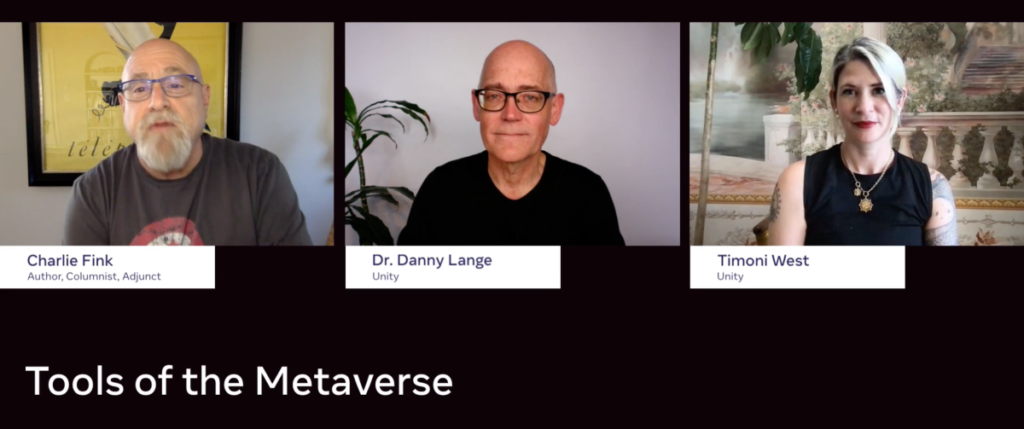How Unity is positioning itself to democratize the metaverse
Dr. Danny Lange and Timoni West of Unity join author Charlie Fink to talk about Unity’s role in supporting the new metaverses springing up. …


“Right now we’re just at the cusp of getting to the point where a lot of technologies, a lot of concepts, are coming together, and will enable a revolution,” said Dr. Danny Lange, senior VP of AI at Unity, during the “Tools for the Metaverse” panel at the GamesBeat “Into the Metaverse” event.
Lange and Timoni West, VP of tools for Unity, joined author Charlie Fink, to talk about Unity’s role in supporting the metaverses that are beginning to spring up, growing in sophistication all the time.
Digital twins, or digital representations of the physical world, such as Niantic’s PokemonGo, or the way Google Maps allows you to visualize the world, have the potential to be metaverses, Lange says.
“At Unity we’re making very significant investments in the concept of digital twins,” he said. “Digital twins could really be a foundational effort in the Metaverse concept. It’s a first step, where we can interact in a digital world. We can learn from it and impact it before we get into the real world. There are a lot of applications, a lot of opportunities there.”
A giant metaverse is arguably the end goal, where users can move seamlessly between worlds, from Roblox’s platform to Snap Inc.’s augmented reality platform, to the PokemonGo world to the VR metaverse of Oculus, but there are still some significant sticking points, West said, a question that goes all the way across the board, from standards to hardware.
“When it comes to 3D interactivity, you not only have the tool set and then also the output to the platform, but you also have different devices, with completely different hardware, that don’t necessarily play nicely together,” he said. “That’s simply something we have to seriously take into account when we think about how to build out these worlds people can go to. It’s not just a matter now of sharing the same syntax or setting up standards. It’s also a matter of making sure that if you do create these worlds — that regardless of where that person is and what device they’re on, they can participate effectively.”
The standardization that exists shares a common thread — they’re worlds that are built with a plugin into Unity, Fink noted. You can bring in new resources and upload them into Altspace or VRChat, because they’re using some common building blocks underneath them. And that’s essential to the democratization of XR and the effort to get more people building it and contributing to, if not a holistic metaverse, at least some of its smaller parts.
One of Unity’s core values is solving the hard problems for their users, West said. And one of the foundational problems today that developers run into is differences in machine learning stacks and computer vision and what the platform gives you.
“Because that’s such a meaty problem, that tends to be what we’ve focused on, even on the tooling side — that’s been Unity’s sweet spot for a long time,” he said. “But then there’s that next layer of people who want visual scripting, who want simplified creation tools. Our hope is that we’re just pushing up the stack, so that we hit more and more people who just want to make an experience and want to bring what’s in their head to life.”
“This is deep in our DNA, to democratize development,” Lange said. “That’s the core of what we’re doing at Unity. We have 1.5 million developers on our platform, and we drive a lot of those developers to the XR space as well.”
AI helps lower the barrier to entry for creating these applications, he added. They develop AI that solves behavioral challenges. You can train your system, characters, objects, to interact with you rather than hand-code it. Unity has a physics engine that emulates gravity and inertia and collision that takes the guesswork out of determining how objects should interact.
They also work on AI for object recognition, so that in a mixed reality application, your application will know what kind of objects it’s looking at and be able to infer some behavior or physical properties from those objects.
“For us it’s about bringing advanced technology to the developers so that they can create much more powerful applications,” he said. “That’s our mission.”
Last year the company launched MARS, or the Mixed and Augmented Reality Studio, which, he said, is the most powerful tool on the market for any user to create mixed reality experiences that allow users to add digital apps that react intelligently to the virtual space.
“There’s a lot of work ahead of us,” said Lange, “but the thing we can learn from the world wide web is that democratization is very important to enable full penetration of the technology.”
“It has to be easy to develop,” he added. “It has to be easy to use. It has to be easy to create content and experiences. It also has to be easy for people to make a living from. I think that Unity is uniquely positioned, if you look at our presence in the market today and where we’re taking gaming, especially for small and independent studios and our support for over 20 different platforms — it’s in our DNA, in our blood, to continue this and bring it into the Metaverse as well.”